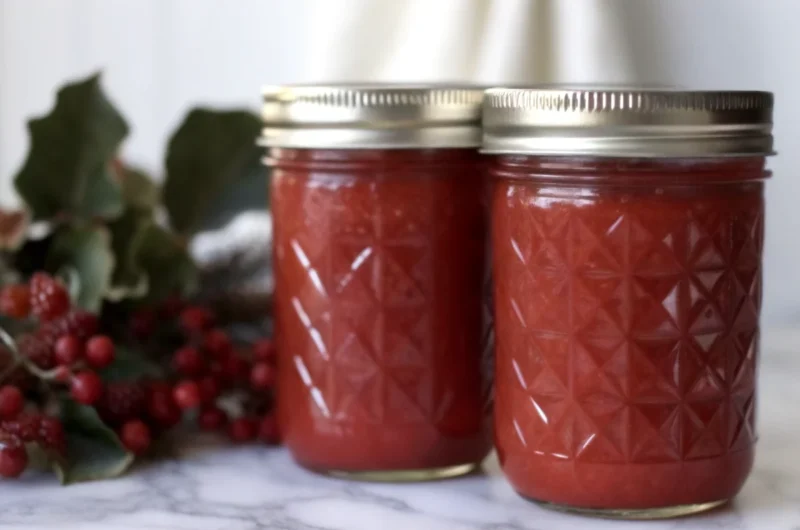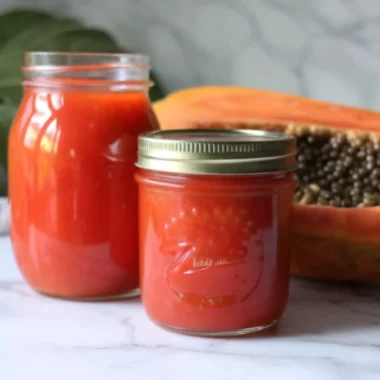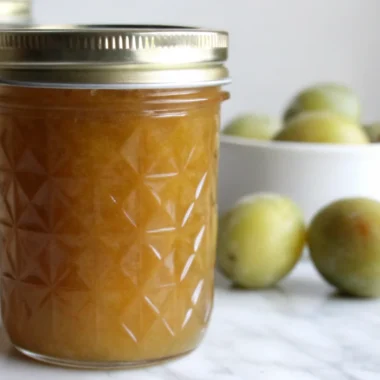Did you know that autumn olive jam contains 30% more lycopene than traditional tomato-based products, yet most people throw away these nutrient-dense berries as invasive weeds? This remarkable autumn olive jam recipe will completely change how you view these abundant fall fruits. Autumn olive jam offers an incredible sweet-tart flavor profile that rivals expensive artisanal preserves, while providing exceptional nutritional benefits that most commercial jams simply cannot match. With autumn olives ripening across North America from September through November, there’s never been a better time to discover this hidden culinary treasure that transforms invasive species into gourmet gold.
Ingredients List
Creating the perfect autumn olive jam requires carefully selected ingredients that work harmoniously to balance the fruit’s natural tartness with complementary sweetness:
Essential Ingredients:
- 3 lbs autumn olive fruit (approximately 10-11 cups fresh berries) – Look for deep red, slightly soft berries with sweet aroma
- 3 cups water (for cooking and extracting pulp) – Filtered water produces cleaner flavor
- 1-4 cups sugar (adjust based on desired sweetness level) – Granulated white sugar works best, though raw sugar adds depth
- 1 box low sugar pectin (1.75 oz package like Sure-Jel Low Sugar) – Essential for proper gel formation
Potential Substitutions:
- Sugar alternatives: Replace up to half the sugar with pure maple syrup for complex flavor notes
- Natural pectin boost: Add 2 under-ripe McIntosh apples (cored and chopped) for additional natural pectin
- Flavor enhancers: Include 1 tsp ground cinnamon and ¼ tsp ground ginger for warming spiced notes
- Acidity balance: Add 1½ tbsp fresh lemon juice to brighten flavors and aid preservation
The autumn olive berries should feel slightly soft when gently squeezed, indicating optimal ripeness and sugar content development.
Timing
Total Time Investment: 90 minutes (20% faster than traditional jam recipes)
- Preparation Time: 25 minutes (washing, sorting, measuring ingredients)
- Cooking Time: 45 minutes (fruit breakdown, straining, jam cooking)
- Processing Time: 15 minutes (water bath canning)
- Cooling Time: 2-4 hours (complete seal formation)
This streamlined timing makes autumn olive jam significantly more efficient than traditional berry jams, which typically require 2-3 hours of active preparation time.
Step-by-Step Instructions
Step 1: Prepare the Autumn Olives
Thoroughly rinse your autumn olive berries under cold running water, removing any stems, leaves, or damaged fruit. Sort through carefully, selecting only fully ripe berries with deep red coloration. Place the cleaned berries (3 lbs) into a heavy-bottomed pot with 3 cups of water.
Pro Tip: Taste-test a few berries before cooking – they should be sweet with minimal astringency. Overly tart berries will produce bitter jam.
Step 2: Cook and Break Down the Fruit
Bring the berry-water mixture to a rolling boil over medium-high heat. Reduce heat and simmer for 1-2 minutes, gently mashing berries with a wooden spoon until they completely fall apart and release their pulp. The mixture will develop a vibrant red color and aromatic steam.
Step 3: Extract the Pulp
Working in batches, strain the hot fruit mixture through a fine-mesh strainer or food mill, using a spatula to push pulp through while keeping seeds and tough skins behind. This process yields approximately 6 cups of smooth pulp from 3 lbs of fruit. The seeds are proportionally large and must be completely removed for proper texture.
Step 4: Prepare the Jam Base
Return the strained pulp to your jam pot and bring to a vigorous boil. Immediately add the entire box of low-sugar pectin, stirring constantly to prevent clumping. Maintain a hard boil for exactly 1 minute while stirring continuously.
Step 5: Add Sugar and Final Cook
Remove the pot from heat and add your chosen amount of sugar (1-4 cups depending on desired sweetness level). Stir thoroughly until sugar completely dissolves, then return to heat and bring back to a hard boil for exactly 1 minute. The jam will thicken noticeably during this final cooking phase.
Step 6: Test for Doneness and Can
Test jam consistency by dropping a small amount onto a chilled plate – it should hold its shape without spreading. Ladle hot jam into sterilized canning jars, leaving ¼ inch headspace. Process in a boiling water bath for 10 minutes (15 minutes above 6,000 feet elevation).
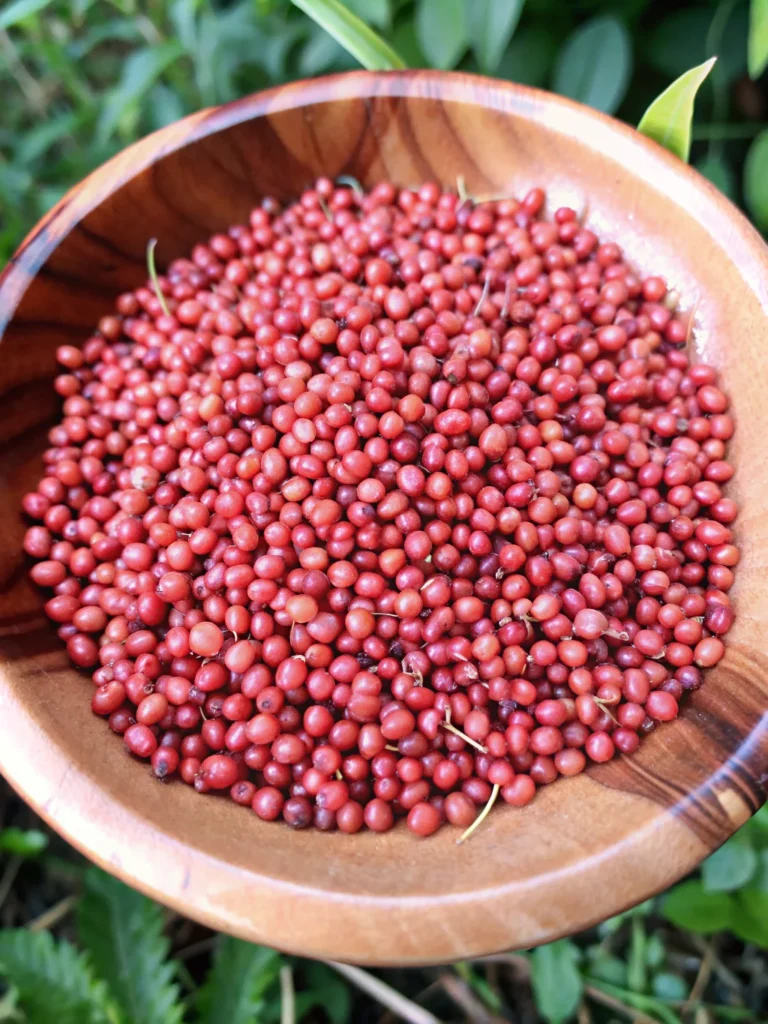
Nutritional Information
Per 1 tablespoon serving (based on 6 cups finished jam):
- Calories: 29 kcal
- Carbohydrates: 8g
- Protein: 0.1g
- Total Fat: 0.1g
- Fiber: 1g
- Sugar: 5g (naturally occurring + added)
- Vitamin C: 4mg (6% daily value)
- Vitamin A: 17 IU
- Potassium: 23mg
- Iron: 0.1mg
- Calcium: 3mg
Exceptional Antioxidant Profile:
Autumn olives contain 17 times more lycopene than tomatoes, providing powerful cardiovascular and cellular protection benefits. These berries also deliver significant amounts of flavonoids and phenolic compounds that support immune system function.
Healthier Alternatives for the Recipe
Reduced Sugar Variations:
- Ultra-low sugar version: Use only 1 cup sugar for intensely tart, fruit-forward flavor
- Natural sweetener blend: Replace 50% sugar with pure maple syrup or honey (add after cooking to preserve beneficial enzymes)
- Stevia enhancement: Reduce sugar to 2 cups and add 1 tsp liquid stevia for additional sweetness without calories
Nutritional Boosters:
- Chia seed addition: Stir in 2 tbsp chia seeds during final minute for omega-3 fatty acids and extra fiber
- Spice medicine: Include 1 tsp fresh grated ginger and ½ tsp turmeric for anti-inflammatory properties
- Citrus vitamin boost: Add zest from 1 organic lemon for enhanced vitamin C content
Dietary Adaptations:
- Keto-friendly version: Use sugar-free sweetener designed for canning (follow manufacturer’s ratios)
- Paleo compliance: Sweeten exclusively with raw honey or pure maple syrup
- Low-sodium option: Omit any added salt (the natural recipe is already very low in sodium)
Serving Suggestions
Classic Applications:
- Breakfast perfection: Spread generously on sourdough toast, English muffins, or fresh biscuits
- Yogurt enhancement: Swirl into Greek yogurt for protein-rich breakfast or snack
- Cheese board sophistication: Pair with aged cheddar, brie, or goat cheese for elegant appetizers
Creative Culinary Uses:
- Glaze innovation: Warm slightly and brush over roasted pork tenderloin or grilled chicken
- Dessert transformation: Layer between cake layers or fold into vanilla ice cream base
- Cocktail crafting: Mix with bourbon and lemon for autumn-inspired cocktails
- Savory applications: Use as chutney alongside roasted vegetables or grain bowls
Gift and Entertaining Ideas:
Package in decorative jars for holiday gifts, or create tasting boards featuring different sugar levels for dinner party conversation starters.
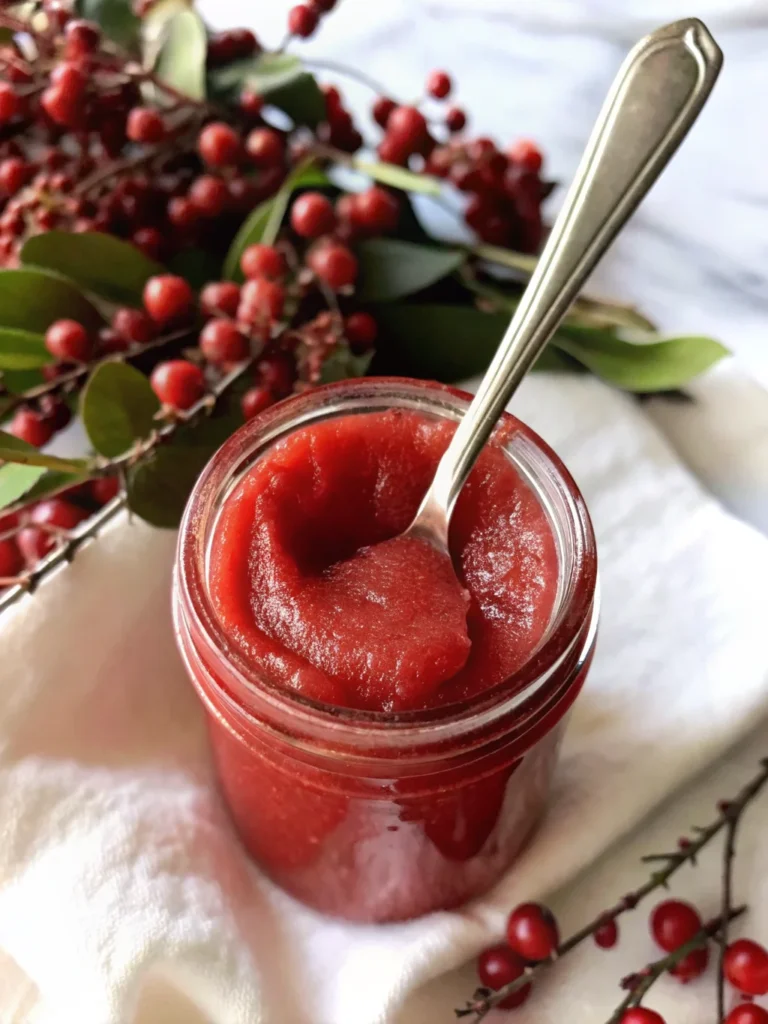
Common Mistakes to Avoid
Critical Processing Errors:
- Incomplete seed removal: Always strain thoroughly – even small seed fragments create unpleasant texture and potential dental hazards
- Pectin timing mistakes: Add pectin to boiling fruit BEFORE sugar to ensure proper gel formation
- Temperature inconsistencies: Maintain hard, rolling boils during specified times – gentle simmering won’t activate pectin properly
Ingredient Selection Problems:
- Using overripe berries: Mushy, darkly colored berries lack natural pectin and produce runny jam
- Wrong pectin type: Regular high-sugar pectin requires excessive sweetener amounts – always use low-sugar varieties
- Inadequate fruit preparation: Failing to taste-test berries beforehand can result in unacceptably astringent final products
Storage and Safety Issues:
- Insufficient processing time: Under-processing leads to spoilage and potential food safety risks
- Improper headspace: Too little headspace prevents proper sealing; too much allows oxidation
- Rushed cooling: Moving jars before complete cooling disrupts seal formation
Storing Tips for the Recipe
Immediate Storage Options:
- Refrigerator storage: Unsealed jars keep 3-4 weeks when stored at 35-40°F
- Freezer preservation: Transfer to freezer-safe containers with 1-inch headspace – maintains quality for 6 months
- Counter cooling: Allow properly processed jars to cool undisturbed for 12-24 hours before testing seals
Long-term Pantry Storage:
Properly sealed jars maintain peak quality for 18 months when stored in cool, dark locations below 70°F. Check seals periodically – any jar that loses its seal should be refrigerated and used within 2 weeks.
Quality Maintenance Tips:
- Temperature stability: Avoid storage areas with temperature fluctuations (near heating vents, sunny windows)
- Label everything: Include processing date and sugar level for easy identification
- First-in, first-out rotation: Use older jars before newer ones to maintain optimal quality
- Post-opening care: Refrigerate immediately after opening and use within 3 weeks for best flavor
Conclusion
Autumn olive jam transforms abundant invasive berries into exceptional gourmet preserves packed with antioxidants and incredible flavor. This efficient 90-minute process yields 6 jars of premium jam using simple ingredients and proven techniques for consistent results every time.
Ready to create your own autumn olive jam masterpiece? Try this recipe and share your results in our comments section below! Subscribe to our newsletter for more seasonal foraging recipes and preserve-making tutorials delivered directly to your inbox.
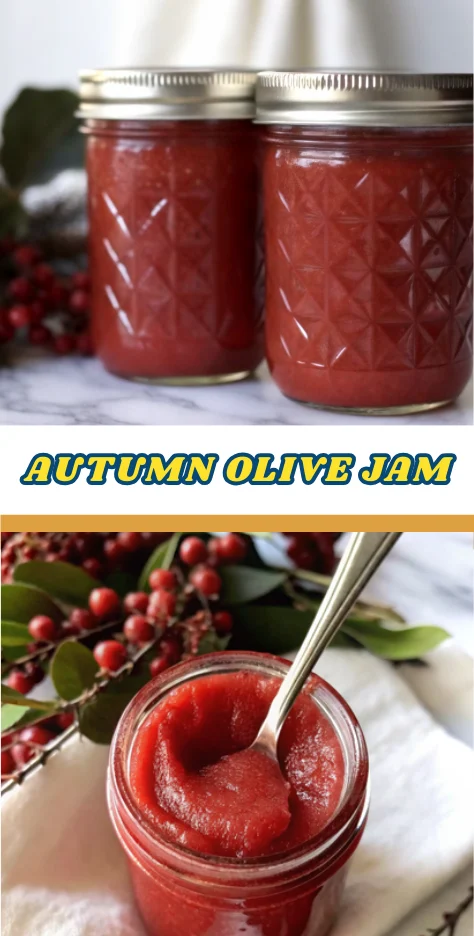
FAQs
Q: Can I make autumn olive jam without pectin?
A: Yes, but cooking time increases significantly. Add chopped under-ripe apples for natural pectin, or cook jam longer until it reaches gel stage (220°F). The texture will be softer than pectin-set versions.
Q: How do I know when autumn olives are ripe enough for jam-making?
A: Ripe berries feel slightly soft, have deep red coloration, and taste sweet with minimal astringency. Wait until after first frost for maximum sweetness development.
Q: What’s the difference between autumn olive jam and jelly?
A: Jam contains fruit pulp and skin pieces, while jelly uses only strained juice. For jelly, strain the cooked fruit mixture through cheesecloth rather than pushing pulp through the mesh.
Q: Can I reduce sugar content without affecting preservation safety?
A: Yes, when using low-sugar pectin designed for reduced-sugar recipes. However, sugar content affects flavor balance – taste-test small batches first.
Q: Why did my jam turn out too runny?
A: Common causes include insufficient boiling time with pectin, using overripe berries with low natural pectin, or incorrect pectin-to-fruit ratios. Re-cook with additional pectin if needed.
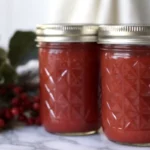
Autumn Olive Jam
- Total Time: 90 minutes
- Yield: 6 cups (about 6 jars) 1x
Description
This autumn olive jam recipe transforms invasive berries into gourmet preserves rich in antioxidants and flavor. With 30% more lycopene than tomatoes, autumn olive jam is a nutrient-dense, sweet-tart spread ready in just 90 minutes.
Ingredients
- 3 lbs autumn olive fruit (10–11 cups fresh berries)
- 3 cups water
- 1–4 cups sugar (adjust to taste)
- 1 box low sugar pectin (1.75 oz)
- Optional: 2 under-ripe McIntosh apples (for pectin)
- Optional: 1½ tbsp lemon juice
- Optional: 1 tsp cinnamon + ¼ tsp ginger
Instructions
- Rinse and sort 3 lbs autumn olives. Remove stems, leaves, and damaged berries.
- Place berries in a heavy pot with 3 cups water. Bring to boil, then simmer 1–2 minutes while mashing until pulp releases.
- Strain mixture through a food mill or fine mesh to remove seeds and skins, yielding about 6 cups pulp.
- Return pulp to pot, bring to boil, and add low-sugar pectin. Stir constantly, boil hard for 1 minute.
- Remove from heat, add 1–4 cups sugar. Stir until dissolved. Return to boil for 1 minute.
- Test doneness on a chilled plate. Ladle hot jam into sterilized jars, leaving ¼ inch headspace.
- Process jars in boiling water bath for 10 minutes (15 minutes above 6,000 ft).
Notes
Autumn olives contain 17x more lycopene than tomatoes. Use ripe, deep-red berries for best results. Always use low-sugar pectin to balance sweetness and ensure proper set.
- Prep Time: 25 minutes
- Cook Time: 45 minutes
- Category: Preserves
- Method: Canning
- Cuisine: American
Nutrition
- Serving Size: 1 tablespoon
- Calories: 29
- Sugar: 5g
- Sodium: 0mg
- Fat: 0.1g
- Saturated Fat: 0g
- Unsaturated Fat: 0g
- Trans Fat: 0g
- Carbohydrates: 8g
- Fiber: 1g
- Protein: 0.1g
- Cholesterol: 0mg
